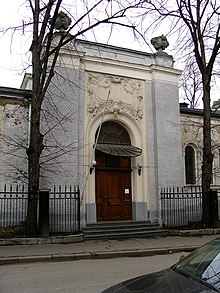William Walcot
This article includes a improve this article by introducing more precise citations. (May 2021) ) |
William Walcot | |
|---|---|
 Gutheil House, 1902–1903 | |
| Born | 10 March 1874 Lustdorf, Russian Empire (now Ukraine) |
| Died | 21 May 1943 (aged 69) Hurstpierpoint, Sussex, UK |
| Nationality | British |
| Occupation | Architect |
| Buildings | Metropol Hotel, Gutheil and Yakunchikova mansions (all in Moscow, Russia) |
William Walcot
Biography
Russia
William Walcot was born in the village of

His largest and best known work was the
Lady's Head became Walcot's trademark, repeated in his later works (usually in place of an arch keystone), and frequently imitated by local craftsmen. For a while, he enjoyed an unprecedented flow of inquiries and secured two high-profile commissions of his own choice. These buildings, soon occupied by foreign embassies, are well maintained and retain most of their original interiors:
- 1899–1900 Yakunchikova House (Prechistensky lane, 10)
- 1902–1903 Gutheil House (Prechistensky lane, 8, Embassy of Morocco)
Walcot's mosaic, signed W.W., adorns the List House in Glazovsky Lane, built by Lev Kekushev.
Walcot's 1902 draft for the Lutheran Cathedral in Moscow won the contest, but the cathedral was eventually built to another architect's design. Walcot published various drafts in architectural magazines, influencing many local architects (Brumfield, fig.58).
In 1904, Walcot lost the contest for the Polytechnical Society Building in Myasnitskaya Street to Adolph Mincus; the building, completed in 1905–1907 by Alexander Kuznetsov (1874–1954), bears some details from Walcot's rejected draft.
United Kingdom

In 1906, Walcot relocated to London. There he was initially employed as a draughtsman for the South African architect Eustace Frere. He rarely returned to practical construction, designing only one London building: 61 St James's Street (1933). Rather, Walcot worked as an architectural draftsman, famous for his artistic presentation of other architects' designs and exhibiting his own work at the Royal Academy summer exhibitions.
Walcot, along with contemporary
Walcot's successful practice was ruined with the outbreak of World War II, and, in 1943, Walcot committed suicide at Hurstpierpoint, Sussex. Walcot's painting and etchings are frequently exhibited; his painting palette is preserved at the Royal Institute of British Architects. He had a retrospective exhibition at the Fine Arts Society in 1974.
References
- William Craft Brumfield, The Origins of Modernism in Russian Architecture, University of California Press, 1991 chapter 3
- William Walcot exh. cat., London, F.A. Soc., 1974
- G. Stamp: The Great Perspectivists, London, 1982
Further reading
- Architectural water-colours & etchings of William Walcot (London: H.C. Dickins, 1919).
- Salaman, M.C. (intro) (1927), Modern Masters of Etching: William Walcot, R.E., 'The Studio' Limited, London.
- William Walcot, An Architect-Etcher and quintessential artist of the Modern British Etching Boom. By Elizabeth Harvey-Lee. A history and on-line exhibition of Walcot's work.
External links

